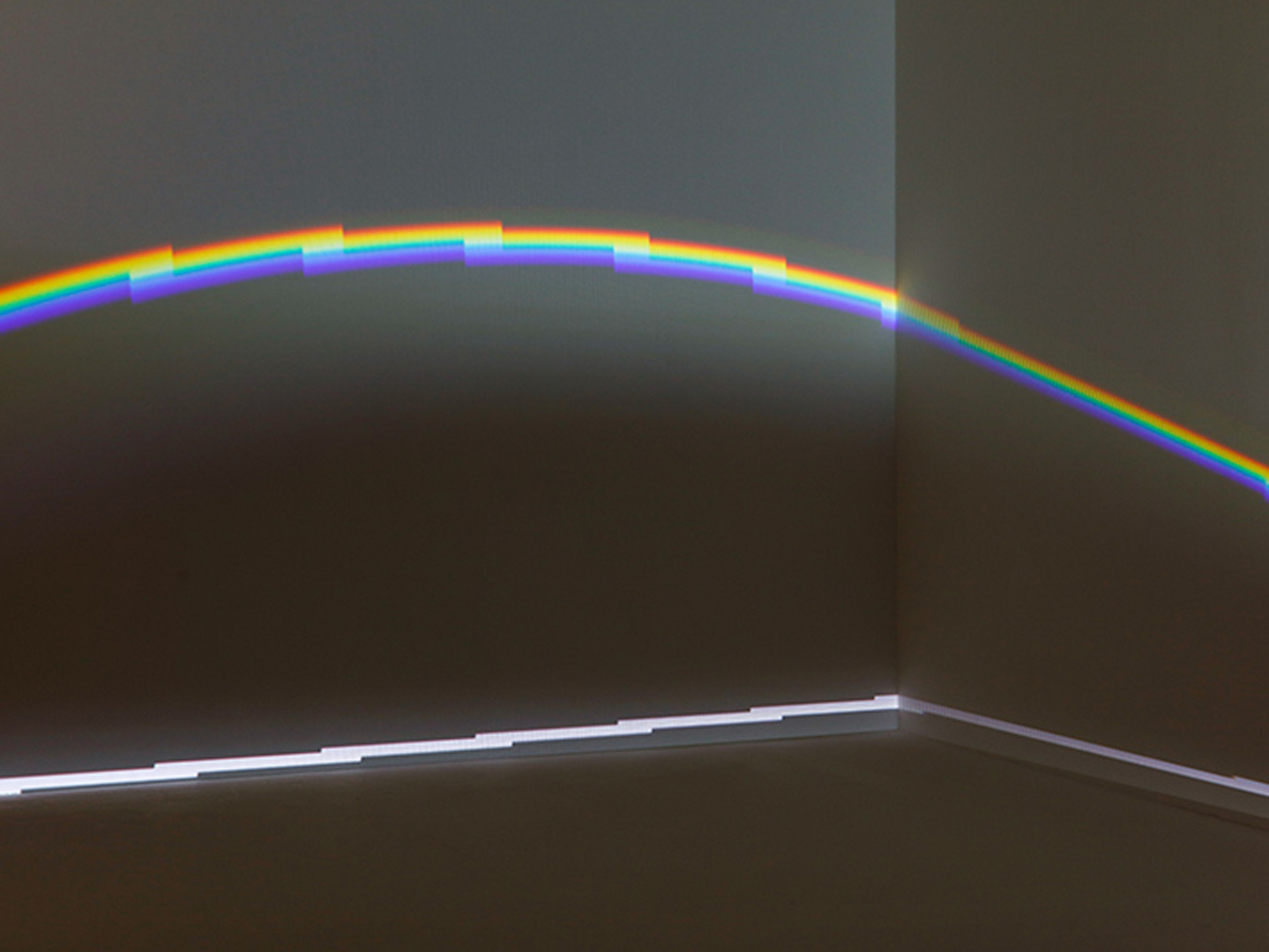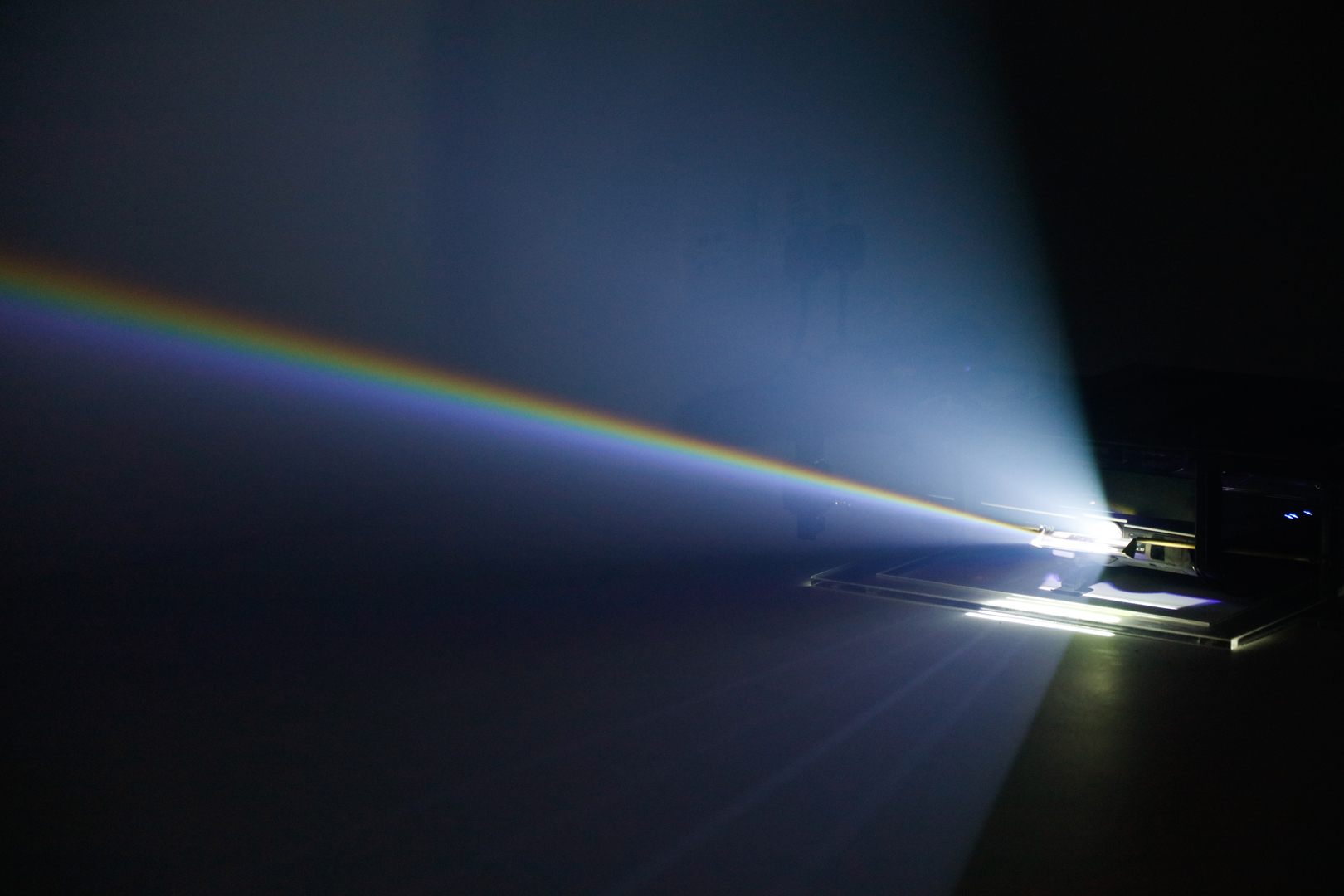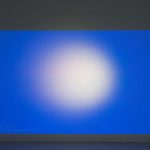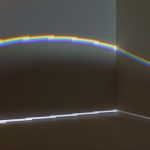Gi Wai Echo Hui: We Can’t See The Rainbow In The White
Artist(s):
Title:
- We Can't See The Rainbow In The White
Exhibition:
- SIGGRAPH Asia 2020: Untitled & Untied
-
More artworks from SIGGRAPH Asia 2020:


Category:
Artist Statement:
Summary
We Can’t See the Rainbow in the White is a process deconstructing light. I deconstruct the white light to monochromatic ‘rainbow’ colour using a prism. When there is light, everything is visible. I decompose the fundamental element in the visual world to let the invisible become visible.
Abstract
When there is light, everything is visible. I decompose the fundamental element in the visual world to let the invisible become visible.
It is a process deconstructing light. I project a white source of light on a surface while using prism and some moving images to “deconstruct” it. “White” is not an independent colour. It is a mixture of colour in the visible spectrum that is composed of the primary colour red, green and blue.
Through refraction of light, I separated the white source with the three primary colours to rainbow light using a prism. After that, I took away green light from white light, leaving a mixture of red and blue light. Without green, the light source gradually reflects a new colour called magenta, hence the ‘rainbow’ becomes a ‘duo-coloured rainbow’. Eventually, I erased red from magenta. The line results in pure blue colour. As blue is a primary coloured light that cannot be further decomposed by the prism, it appeared the ultimate light source in a monochromatic ‘rainbow’ color.
Technical Information:
All the electrical equipment should be placed on the end of the slanted platform, giving the far distance from the projection wall. The fog releasing the button of the fog machine is controlled by the Arduino. The fog machine must to switched on and off every day manually before and after the opening hour. The projector, BrightSign player and the motorised prism device will be switched on and off automatically every day according to the opening hour.
Process Information:
We all know that when there is light, everything is visible. Can we recognise the elements that composed light through our eyes? This project starts with my curiosity about elements that make up the natural appearance of “light”. The intangibility of light is beyond description, is ‘untitled’. I decompose the fundamental of light to turn it into individual elements for us to see. The ‘Untitled’ is being ‘Untied’ by the motorised prism and controlled light source.
White light is not included in the visible spectrum. It is ‘untitled’ in the visible spectrum. It is a mixture of different wavelength of visible light. I consider white light as an ‘optical illusion’. The inability to differentiating the mixture of light in discrete colours may give us the ‘illusion’ of the colour white.
I decomposed the white light by prism by refraction and pixelization. I removed the primary colours step by step until the primary blue colour has left. A bright blue light flashes, leaving the ‘purest’ form of light in our brain as the after-image. Human eyes recognize smooth, analogue light in the air. When the light is shown as a projection, it is a shape formed by pixels. I transformed a smooth line into pixelated line to exaggerate the pixelated reality. Afterwards, I broke the pixelized line into fragments. I tried to ‘cut’ the line in a physical way to reduce it into the ‘simplest’ form.
I call this process the deconstruction of light. I question the ways human define “reality” by using optical illusion. Light, shapes and line refer to the fundamental forms of reality. I wanted to manifest the reality in an alternate way, so I created an alternative scenery by deconstructing the white light.
A rainbow produced by a prism is not an unusual picture. I would say the differences that make my work distinguishable is that I am turning the rainbow into a moving image of the narrative of light deconstruction.
I project a white source of light on a surface while using prisms and some moving images to “deconstruct” it. “White” is not an independent colour. It is a mixture of colour in the visible spectrum that is composed of the primary colour red, green and blue.
Through the refraction of light, I separated the white source with the three primary colours to rainbow light using a prism. After that, I took away green light from white light, leaving a mixture of red and blue light. Without green, the light source gradually reflects a new colour called magenta, hence the ‘rainbow’ becomes a ‘duo-coloured rainbow’. Eventually, I erased red from magenta. The line results in pure blue colour. As blue is a primary coloured light that cannot be further decomposed by the prism, it appeared the ultimate light source in a monochromatic ‘rainbow’ colour. The moving image not only helps translate the mechanism but also becomes an alternative scenery.
Moreover, throughout the narrative, there is a device controlling the movement of the prism. I want to add a human touch to the robotic motion of the device. Therefore, the motions varied from moving fast or slow, dramatically shaking, and calmly swinging.
Other Information:
Inspiration Behind the Project
The motive behind this project is my ongoing research on the biological limitations of human senses, particularly seeing. At that time, my work usually makes use of optics and illusion to question reality. The sight could be considered one of the most dominant senses for us to perceive the world. When there is light, everything is visible. The idea of this project was informed by the scientific and artistic research on light. Light is a fundamental element in the visual world that composes our seeing. White is not pure but a mixture of colours in the visible spectrum that is composed of the primary colour red, green, and blue. I would want the process of deconstructing light as a way to demystify the authority of our sense of sight or question the belief in our senses to perceive the ‘reality’.
Key Takeaways for the Audience
I would be appreciated if the audience could remember the motive behind my project, which is to challenge the reality we see.







